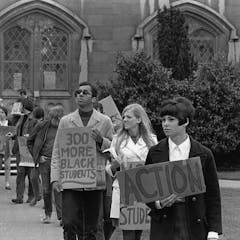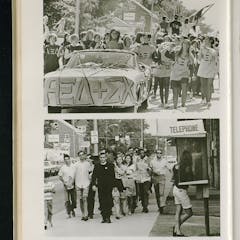
Articles on 1960s
Displaying 1 - 20 of 34 articles

Throughout the 1960s and 1970s, conservative activists led a counterattack against campus antiwar and civil rights demonstrators by demanding action from college presidents, the courts and the police.

From conscientious objectors to hippies and seniors, intentional communities offer refuge and purpose for people seeking a different way of life.

My Sister Jill disrupts ideas of colonial glory with a troubling depiction of family violence, PTSD, homophobia and the ruinous intergenerational impacts of patriarchal oppression on everyone.

The New York Times’ publication of the Pentagon Papers showed the paper was willing to jeopardize connections to other powerful institutions, including the government, to serve the public interest.

Washington isn’t a state that typically comes to mind in discussions about student-led protests from the Civil Rights Movement. A Black history professor seeks to change that with a new book.

An English professor takes a critical look at why today’s students are assigned the same books that were assigned decades ago – and why American school curricula are so difficult to change.

Judith Durham was lead singer of The Seekers and a solo artist. One of Australia’s most recognisable voices, she has passed away at 79.

This brainy feminist romp of a novel, loved by Rachel Cusk and Maria Semple, is often compared to Brideshead Revisited. But Carol Lefevre says it’s more like a sexy, sweary version of Nancy Mitford in 1960s London.

Not the bright and optimistic period that pop art at first glance would suggest, a lot of Warhol’s work is about death and destruction.

College presidents worked both at the forefront and behind the scenes in fighting for African Americans’ civil rights in the 1960s.

For 200 years, a small number of countries have exploited the marine wildlife of Antarctica, often with devastating impact on their populations.

The US has a long history of forced sterilization campaigns that were driven by the bogus ‘science’ of eugenics, racism and sexism.

The agency’s earliest ad campaigns emphasized youthful idealism, patriotism and travel opportunities. That was an easier sell than urging Americans to enlist in an anti-communist operation.

Unbridled ambition and bruised egos created an irreparable fissure.

Half a century after the federal government voided Jim Crow laws, the criminal justice system still discriminates against African Americans.

Recent blackface scandals that involve college yearbooks have overshadowed how yearbooks also chronicled important turning points in the history of US higher education, a historian argues.

The Liverpool comic scored with the third-highest selling single of the 1960s.

Desperate to achieve fame by any means necessary, Manson was ahead of his time: Today, the delirious pursuit of fame has gone mainstream.

The murderous cult leader’s notoriety has not diminished over four decades in a US jail.

John Lennon and Yoko Ono visited Canada on a peace mission: They met with leaders and asked difficult questions, relevant today. How do we effectively protest against social injustices and war?
